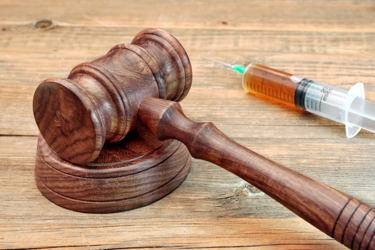IP & Patent Protection At The Perilous Pace Of Biopharma

By Matthew Pillar, Editor, Bioprocess Online

Fast-tracks and breakthrough statuses are piling up at an unprecedented clip, and the President is promising the spoils of war to the first vaccine manufacturer to smash speed-to-market records (preferably prior to November 3). It’s madness out there. That’s one reason it’s incumbent on biopharma execs—every one of them in the C-suite—to ensure protection of their intellectual property and patents.
It would be tough to find a parallel to Kevin Buckley’s grasp of the legal considerations associated with commercializing a biologic therapy. During his more than 20 years in practice, he’s managed intellectual property, transactional, and regulatory matters for what is now known as Denton’s (the largest law firm on the planet) and the University of Central Florida (the largest university in the U.S.). He handled the same issues in-house for an international biopharmaceutical company, and CureMetrix, the first medical device company to obtain FDA clearance for artificial intelligence (AI)-enabled breast cancer detection. In 2013, he formed Torrey Pines Law Group, a multi-attorney firm dedicated to intellectual property, regulatory services, reimbursement, and technology transactions in life sciences and healthcare product commercialization. He also recently began serving as general counsel for the biotech CureMatch which uses AI and personalized medicine systems to identify drug combinations for precision cancer therapy.
Buckley’s focus on life sciences didn’t occur by happenstance. Before attaining his J.D. from the University of Pittsburgh School of Law, Buckley earned a B.S. in Biochemistry from UC San Diego where he was an undergraduate Research Scholar. He spent the six years prior to his life sciences IP and patent law career researching immuno-oncology before attending law school. Lawyers with his biology chops are hard to come by. Who better to speak with about the current state of IP protection and patent law in a pharma industry whose pace of development has gone from banal to blisteringly brisk over the past few years? BioProcess Online caught up with Buckley for a timely discussion on the central tenets of IP and patent protection for biopharma products. His advice on when to begin putting those protections in place might surprise you.
Where Business, Science, And Law Collide

Buckley goes on to outline five key points on which business, science, and legal leaders should focus their collective efforts. These points provide a framework for the dialog he says is prerequisite to IP protection and patent success. On each point, Buckley offers insight into the conversations the quorum should be having, and the questions they should be asking about protecting your IP.
- Intellectual Property. “The boom in COVID-19 vaccine and prophylactic development provides a case in point on the importance of strategically protecting your IP. You need to discuss what preceded your candidates to treat similar conditions, in this case SARS-CoV-1. That’s “prior art” that you must analyze and analyze quickly. It’s not a game of first-to-invent anymore, it’s about being first to the Patent & Trademark Office. If you’re not there first, you lose. Conduct patentability and freedom to operate searches. If there’s a broad patent out there that’s blocking you, you’ll need to develop a significantly improved therapy or workaround to avoid FTO (freedom to operate) problems.”
- Licensing. “The committee of business, science, and legal stakeholders should be making ongoing determinations of the value of products that could be marketed by the company, licensed out, or be sold, and they should be constantly evaluating what’s blocking the company from that value. What, for instance, does the company need to in-license to maintain FTO? Conversely, address what IP can be readily captured within the company that could be used to block competitors, enforced, or licensed.”
- Funding. “How do I obtain funds to support R&D, and investments to support the increasing cost of operations required to, for example, stay listed on the stock exchange, or meet diligence milestones, or get acquired if that’s the goal? Often your IP is your most valuable asset, and your IP needs to protect what you predict will be cleared or approved for sale. If you’re applying for a patent on a therapeutic, prophylactic, or diagnostic that is unlikely to obtain regulatory approval, be reimbursed, be effectively licensed and sublicensed for manufacturing and distribution, or retain FTO, then you’re going in the wrong direction.”
- Regulatory/Standards. “Your 510(k), PMA (premarket notification), IND, NDA and BLA strategies are intricately linked to your IP, licensing, funding, and post-market strategies. Your IP strategy needs to evolve with emerging regulatory clearance/approval guidance, especially in the COVID-19 environment, as well as reimbursement strategy. If you don’t get a CPT (Current Procedural Terminology) code to have your therapeutic reimbursed by insurance companies, patients may not be able to afford it and doctors are less likely to prescribe it. Also discuss adherence to standards put forth by ISO, IEEE, UL, ASTM, ASME, and NIST as well as cGXP. All of this can inform what should be protected as IP or in a patent application, and that is a huge step toward success.”
- Post-Market Considerations. “With predicting success in mind, talk about pharmacovigilance, safety data exchange agreements, ongoing studies while on the market, the existing biopharmaceuticals on the market to treat the condition, and their safety, or manufacturing improvements or violations. This is all something to be considered in an ongoing, evolving IP and patent protection strategy and pharmaceutical lifecycle management strategy. Remember that IP, such as improvements, new formulations, new indications (i.e., COVID-19), new combinations, hybrid devices/drugs, and the like may be independently patentable and effectively extend patent term on the underlying therapeutic, if your IP strategy is implemented appropriately.”
If you’re not predicting or fully anticipating the successful entry into the commercial market, and activities that occur on the market, Buckley says, you’re not going to have all these bases covered.
IP Mistakes Biopharmas Make
The firm Buckley runs keeps itself busy working with new biotechs that make the mistake of filing a patent application and drafting claims that don’t cover what’s either on the market or predicted to be on the market. When Buckley inherits these filings, or work is transferred to him by new clients, there is often work to do. “Mistakes like this are common,” he says. “The field is stacked with brilliant Ph.Ds. who have never worked with venture capital, or corporate counsel, and who sometimes don’t know the difference between a patent and a trademark. They often don’t know the practical steps of taking products to market.” In other cases, Buckley says, business representatives without a scientific background assume that it’s as easy to win distribution and supply agreements, or develop CMC strategies, which are very different strategically in biopharma when compared to other industries. Those situations, he says, often lead to failure points as early as pre- and early-clinical stages. “In each case, siloes are the enemy,” he says. “That’s why collaboration among business, science, and legal stakeholders is so important.”
The Biopharma Opportunity Is Ripe
Buckley says it’s a great time for biotechs to expedite R&D, medical device clearances, drug and biological approvals, as well as patent filings, with a host of federal assistance—including the Small Business Innovation Research (SBIR) and Small Business Technology Transfer (STTR) programs, DOD and NIH funding, and a willing FDA—poised as enablers. “If you want to blast a COVID-19 treatment through the FDA and patent and trademark offices, there are many ways to expedite that using federally sponsored programs to waive fees and reduce review time, from diagnostics through therapeutics,” he says.
Speaking specifically to academically-spawned biotech startups, Buckley is also bullish about industry partnerships as a means of expediting therapeutic success. Forging a path forward via collaboration with existing life sciences companies, he says, increases the likelihood that the business/science/legal trifecta strategy will pay dividends at the funding and pre-submission filings stages. “Universities should be looking more quickly to industry to help them grease the skids. Collaborative industry and university environments, especially with respect to COVID-19 vaccines, therapeutics, and diagnostics, can unleash a lot of existing R&D, safety and efficacy data,” he says. Industry also brings to the table the wherewithal on downstream regulation analysis, pre-submission filings, and dossiers necessary for regulatory (FDA, EMA, etc.) and successful reimbursement strategies. In Buckley’s experience, the earlier the two work together the more cross-pollination of business, science, and law expertise takes place. And, he says, when patent applications are submitted with both industry and university input, they typically get through the international patent and trademark offices faster.
Of course, when it comes to intellectual property and patents, sharing can be scary. That’s why Buckley advises that formal collaboration agreements be put in place from the outset of a partnership. “These agreements typically take place after IP is formed and due diligence is conducted, but because we’re moving so fast in the COVID-19 environment, these collaborations are often necessary earlier, before the science is fully fleshed out,” he says. “That can be a bit unsettling, but protections can still be accommodated in collaboration agreements to provide the assurances that inventors, universities, and industry desires.” Despite the perception of risk, he says collaboration is often necessary to “get to market first.” “In the context of early partnering in a coronavirus environment that’s fueling expeditious approvals and emergency use authorizations, collaboration can feel a bit scary,” admits Buckley, “but COVID-19 is scarier. There’s no time to slow down, so share and work together early,” he advises.
Asked for some practical advice for biopharma leaders who want to ensure the suggested “crosstalk” among business, science, and legal representatives, Buckley doesn’t hesitate. “Every biotech has SOPs. Mandate the crosstalk. If it’s not occurring, revise your SOPs or fire people.” Speaking specifically to new and emerging companies, Buckley suggests hiring commercialization consultants and/or working with business incubators with expertise on IP, patent, and commercialization strategy. “Regardless of your commercial stage—whether seeking R&D investment, an acquisition, a clinical filing, and so on—if you can’t prove that your technology is novel and non-obvious, and beat your competition to the patent office, you’re at high risk of being dead in the water in this COVID-19 environment.”
